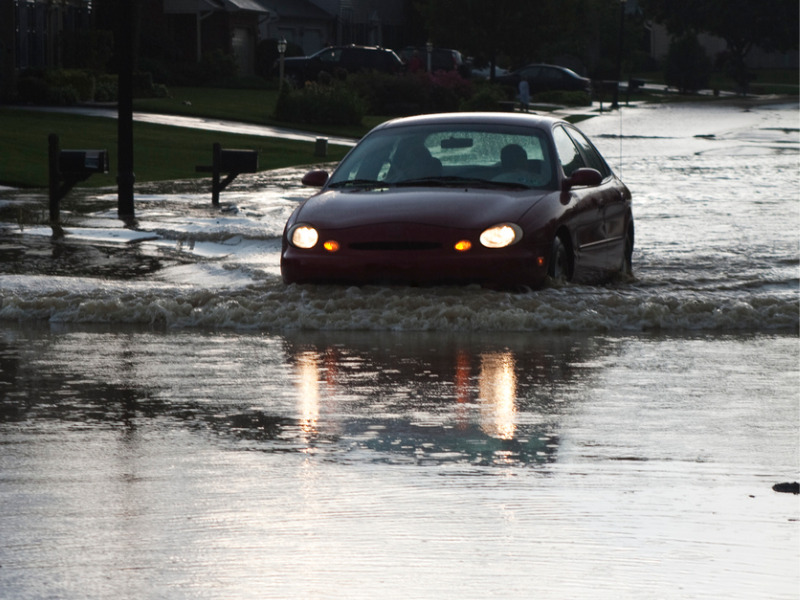Are you covered for driving through flood water?

British Columbia’s Civil Resolution Tribunal (CRT) has ruled in favour of the province’s public auto insurer after finding it properly classified a water-damaged vehicle under collision coverage.
At issue was whether Insurance Corporation of British Columbia (ICBC) correctly determined water damage fell under collision coverage or whether it should have fallen under comprehensive coverage, as driver Michelle Kovacs had argued.
CRT ultimately dismissed the dispute, finding Kovacs drove onto a flooded road and “collided” with water. ICBC determined the vehicle was a write-off, and found Kovacs responsible for paying a $500 deductible.
In ruling for ICBC, tribunal vice chairwoman Andrea Ritchie relied on Kovacs’ original report to the insurer indicating she drove through a flooded roadway. Ritchie also referenced an engineering report from ICBC that found the water damage could not have been caused by having water splash onto the vehicle as Kovacs pulled over to the side of the road, as Kovacs later claimed.
“The problem for Ms. Kovacs is that her explanation of the incident, and in particular whether she drove into the water, is inconsistent,” Ritchie wrote in Kovacs v. ICBC, released May 30.
The incident occurred on Nov. 16, 2021, in Langley, B.C. during the historic atmospheric flooding — the costliest severe weather event in provincial history.
Kovacs argued the incident should fall under comprehensive coverage because the damage was due to rising water while her vehicle was stopped at the side of the road. ICBC contended Kovacs drove into a body of water and collided with an object (the water), causing damage to the car’s engine and interior.
A motorist drives on a service road along the closed Trans-Canada Highway as floodwaters fill the ditches beside the highway and farmland in Abbotsford, B.C., on Wednesday, December 1, 2021. THE CANADIAN PRESS/Darryl Dyck
“On the information before me, I find it more likely than not that Ms. Kovacs attempted to drive through the flooded road, which caused her engine to seize and stop running,” Ritchie wrote in the decision.
ICBC’s Autoplan Optional Policy terms define collision and comprehensive coverage as follows:
“Collision coverage” means coverage for loss or damage caused by upset of a vehicle or collision of a vehicle with another object, including, but not limited to… the roadway being travelled on or an object on, in, under, over or adjacent to the roadway, including… any body of water…
“Comprehensive coverage” means coverage for loss or damage other than loss or damage to which collision coverage applies and includes coverage for loss or damage caused by… rising water…
In Kovacs’ initial report to ICBC the day after the incident, she stated there was some flooding on the road, but it “did not look deep” as other vehicles and a cyclist went through ahead of her. She claimed when she drove through the water, her “car seized up and died.”
After ICBC decided the incident fell under collision coverage, Kovacs provided further statements to the insurer. In a Jan. 10, 2022 statement, Kovacs contended she “never drove into anything,” crossed some railroad tracks and saw the road ahead was flooded. She claimed she tried to drive but water from “other vehicles” poured into her car.
One month later, on Feb. 16, 2023, Kovacs again said she stopped behind another vehicle and cyclist but vehicles passed her in both directions. This caused waves of water to flood into her car.
In her submissions for the CRT, Kovacs said she drove over the railroad tracks and could clearly see flooding on the road ahead, Ritchie wrote. Kovacs said she pulled over to the side of the road so other vehicles could pass as she decided what to do. Two large commercial trucks then passed, sending waves of water into her car.
In the ruling, Ritchie relied on an ICBC report from veteran professional engineer David Little from CEP Forensic. Little determined that water splashing from oncoming or passing vehicles “would not have resulted in a significant or sustained rise in the water level within the engine compartment.” However, Little explained if the vehicle was driven through a deep and prolonged area of flooding, water would have ample opportunity to enter the air intake and engine.
“Mr. Little provides calculations that… Ms. Kovacs’ vehicle had driven 80 metres through the flooded road,” the decision read. “It is his opinion that Ms. Kovacs’ vehicle sustained engine damage as a result of being driven through the flooded road, and that the engine would not have been damaged if she had pulled over to the side of the road before entering the flooded area.”
Feature image by iStock.com/lissart







